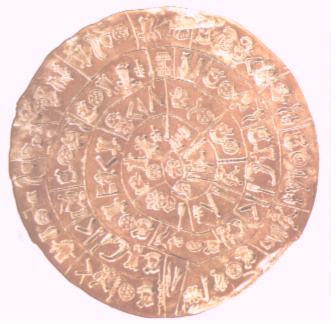
|
|
|
 |
The disc of Phaistos, was found at the beginning of this century amid the ruins of the ancient town of Phaistos in Crete during the campain of the Italian archaeologist F.Halbherr , and it is a singularity in the series of written documentations of the Past: no other registration has this type of ideographs, or characters, and for this reason it is of difficult, if not impossible, deciphering. Nevertheless it is interesting to notice the type of images representing the characters. We see in fact concepts and situations according very good to a Mediterranean context: plants, tools and weapons and animals ( i'm citing from the book of L.Godart " Il Disco di Festo: l' enigma di una Scrittura "). Among the various "characters" very realistic images of a warlike world are noticed: captives and also soldiers :Is that possible now that potential victims of this world have very simply adopted concepts that sure would have had to provoke sadness or loathing? Or, rather, was it a matter simply of a self-portrayal ? |
| ...that
is to say that, the head represented in ideogram #2 (the plumed head) would
be either
the author of the Disc, or of an allied. |
 |
 |
ideogram of the prisoner (#4) |
| A site with
a listing of many other sites relating to the interpretation of the Disc
of Phaestos is
Efforts to decipher.. by A. Svoronos. Here a little attempt of
mine to understand some aspects
|
|
|
|
|
